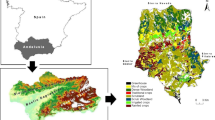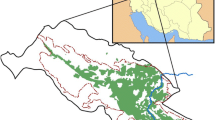Abstract
Hydrological models are often linked with other models in cognate sciences to understand the interactions among climate, earth, water, ecosystem, and human society. This paper presents the development and implementation of a decision support system (DSS) that links the outputs of hydrological models with real-time decision making on social-economic assessments and land use management. Discharge and glacier geometry changes were simulated with hydrological model, water availability in semiarid environments. Irrigation and ecological water were simulated by a new commercial software MIKE HYDRO. Groundwater was simulated by MODFLOW. All the outputs of theses hydrological models were taken as inputs into the DSS in three types of links: regression equations, stationary data inputs, or dynamic data inputs as the models running parallel in the simulation periods. The DSS integrates the hydrological data, geographic data, social and economic statistical data, and establishes the relationships with equations, conditional statements and fuzzy logics. The programming is realized in C++. The DSS has four remarkable features: (1) editable land use maps to assist decision-making; (2) conjunctive use of surface and groundwater resources; (3) interactions among water, earth, ecosystem, and humans; and (4) links with hydrological models. The overall goal of the DSS is to combine the outputs of scientific models, knowledge of experts, and perspectives of stakeholders, into a computer-based system, which allows sustainability impact assessment within regional planning; and to understand ecosystem services and integrate them into land and water management.
Similar content being viewed by others
References
Arnell N W, Lloyd-Hughes B. 2014. The global-scale impacts of climate change on water resources and flooding under new climate and socio-economic scenarios. Climatic Change, 122(1–2): 127–140.
Basso B, Ritchie J T. 2015. Simulating crop growth and biogeochemical fluxes in response to land management using the SALUS model. In: Hamilton S K, Doll J E, Robertson G P. The Ecology of Agricultural Landscapes: Long-term Research on the Path to Sustainability. New York: Oxford University Press, 252–274.
Biswas A K. 2008. Integrated water resources management: is it working? International Journal of Water Resources Development, 24(1): 5–22.
Chen Y N, Li W H, Xu C C, et al. 2015. Desert riparian vegetation and groundwater in the lower reaches of the Tarim River basin. Environmental Earth Sciences, 73(2): 547–558.
Chenoweth T, Dowling K L, St. Louis R D. 2004. Convincing DSS users that complex models are worth the effort. Decision Support Systems, 37(1): 71–82.
Disse M. 2016. Sustainable land and water management of River Oases along the Tarim River. Proceedings of the International Association of Hydrological Sciences, 373: 25–29.
Doorenbos J, Kassam A H. 1979. Yield Response to Water. Rome: FAO, 257.
Duethmann D, Menz C, Jiang T, et al. 2016. Projections for headwater catchments of the Tarim River reveal glacier retreat and decreasing surface water availability but uncertainties are large. Environmental Research Letters, 11(5): 054024.
Feng Q, Endo K N, Cheng G D. 2001. Towards sustainable development of the environmentally degraded arid rivers of China–a case study from Tarim River. Environmental Geology, 41(1–2): 229–238.
Flörke M, Kynast E, Bärlund I, et al. 2013. Domestic and industrial water uses of the past 60 years as a mirror of socio-economic development: a global simulation study. Global Environmental Change, 23(1): 144–156.
Giordano M, Shah T. 2014. From IWRM back to integrated water resources management. International Journal of Water Resources Development, 30(3): 364–376.
Güntner A, Bronstert A. 2004. Representation of landscape variability and lateral redistribution processes for large-scale hydrological modelling in semi-arid areas. Journal of Hydrology, 297(1–4): 136–161.
Herrero M, Thornton P K, Bernués A, et al. 2014. Exploring future changes in smallholder farming systems by linking socioeconomic scenarios with regional and household models. Global Environmental Change, 24: 165–182.
Jeffrey P, Gearey M. 2006. Integrated water resources management: lost on the road from ambition to realisation? Water Science & Technology, 53(1): 1–8.
Liu G L, Yin G, Kurban A, et al. 2016. Spatiotemporal dynamics of land cover and their impacts on potential dust source regions in the Tarim Basin, NW China. Environmental Earth Sciences, 75(23): 1477.
Liu X P, Meng M. 2011. Sustainable land use and the coupling relation of ecological economic harmonious development: a case study of Tarim River Basin. Arid Land Geography, 34(1): 173–178. (in Chinese)
Liu Y B, Chen Y N. 2006. Impact of population growth and land-use change on water resources and ecosystems of the arid Tarim River Basin in Western China. The International Journal of Sustainable Development & World Ecology, 13(4): 295–305.
Lv X, Liu X P, Li Z B. 2016. Coupling of ecological economic system in Tarim River Watershed. In: Qu F T, Sun R M, Guo Z X, et al. Ecological Economics and Harmonious Society. Singapore: Springer, 197–208.
McCown R L. 2002. Locating agricultural decision support systems in the troubled past and socio-technical complexity of ‘models for management’. Agricultural Systems, 74(1): 11–25.
Pedro-Monzonís M, Jiménez-Fernández P, Solera A, et al. 2016. The use of AQUATOOL DSS applied to the System of Environmental-Economic Accounting for Water (SEEAW). Journal of Hydrology, 533: 1–14.
Power D J, Sharda R, Burstein F. 2015. Decision support systems. Volume 7. Management information systems. In: Cooper C L. Wiley Encyclopedia of Management. New York: John Wiley & Sons, Ltd, 1–11.
Quevauviller P. 2010. Is IWRM achievable in practice? Attempts to break disciplinary and sectoral walls through a science-policy interfacing framework in the context of the EU Water Framework Directive. Irrigation and drainage systems, 24(3–4): 177–189.
Rumbaur C, Thevs N, Disse M, et al. 2015. Sustainable management of river oases along the Tarim River (SuMaRiO) in Northwest China under conditions of climate change. Earth System Dynamics, 6(1): 83–107.
Thomas F M, Jeschke M, Zhang X M, et al. 2017. Stand structure and productivity of Populus euphratica along a gradient of groundwater distances at the Tarim River (NW China). Journal of Plant Ecology, 10(5): 753–764.
Visconti P, Bakkenes M, Smith R J, et al. 2015. Socio-economic and ecological impacts of global protected area expansion plans. Philosophical Transactions of the Royal Society B: Biological Sciences, 370(1681): 20140284.
Wenkel K O, Berg M, Mirschel W, et al. 2013. LandCaRe DSS–An interactive decision support system for climate change impact assessment and the analysis of potential agricultural land use adaptation strategies. Journal of Environmental Management, 127(Suppl.): S168–S183.
West G G, Turner J A. 2014. MyLand: a web-based and meta-model decision support system framework for spatial and temporal evaluation of integrated land use. Scandinavian Journal of Forest Research, 29(Suppl.): 108–120.
Xu H L, Ye M, Li J M. 2008. The water transfer effects on agricultural development in the lower Tarim River, Xinjiang of China. Agricultural Water Management, 95(1): 59–68.
Yu Y, Disse M, Yu R D, et al. 2015. Large-scale hydrological modeling and decision-making for agricultural water consumption and allocation in the main stem Tarim River, China. Water, 7(6): 2821–2839.
Yue H L, Zhu Y P, Xue Y, et al. 2014. Study on counties agricultural economic intelligent decision-making support system (IDSS) based on GIS and knowledge. Advanced Materials Research, 889–890: 1319–1322.
Zadeh L A. 1983. The role of fuzzy logic in the management of uncertainty in expert systems. Fuzzy Sets and Systems, 11(1–3): 199–227.
Zhang Q, Sun P, Li J F, et al. 2015. Assessment of drought vulnerability of the Tarim River basin, Xinjiang, China. Theoretical and Applied Climatology, 121(1–2): 337–347.
Zhang Z, Hu H, Tian F, et al. 2014. Groundwater dynamics under water-saving irrigation and implications for sustainable water management in an oasis: Tarim River basin of western China. Hydrology and Earth System Sciences, 18(10): 3951–3967.
Zhao R F, Chen Y N, Li W H, et al. 2009. Land cover change and landscape pattern in the mainstream of the Tarim River. Acta Geographica Sinica, 64(1): 95–106. (in Chinese)
Acknowledgements
This study was supported by German-Sino bilateral collaboration research project SuMaRiO funded by the German Federal Ministry of Education and Research. We are grateful to the support of NSFC-UNEP Project (41361140361): Ecological Responses to Climatic Change and Land-cover Change in Arid and Semiarid Central Asia during the Past 500 Years. This work is the outcome of the interdisciplinary cooperation research among 11 German and 9 Chinese universities and research institutes. Many further researches and projects can learn experience from the algorithm and methodologies of the DSS, which is applicable to other regions. The DSS is free available on request. Comments and further discussions are welcome.
Author information
Authors and Affiliations
Corresponding author
Rights and permissions
About this article
Cite this article
Yu, Y., Chen, X., Huttner, P. et al. Model based decision support system for land use changes and socio-economic assessments. J. Arid Land 10, 169–182 (2018). https://doi.org/10.1007/s40333-018-0091-1
Received:
Revised:
Accepted:
Published:
Issue Date:
DOI: https://doi.org/10.1007/s40333-018-0091-1




